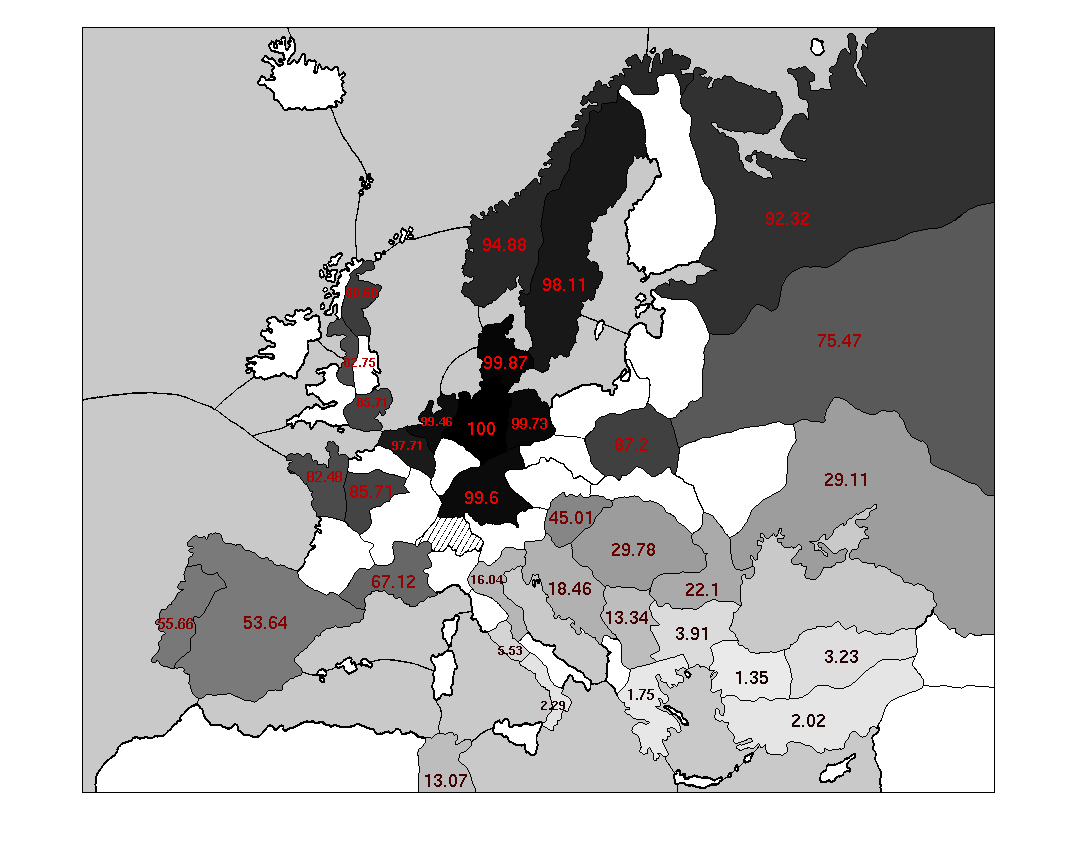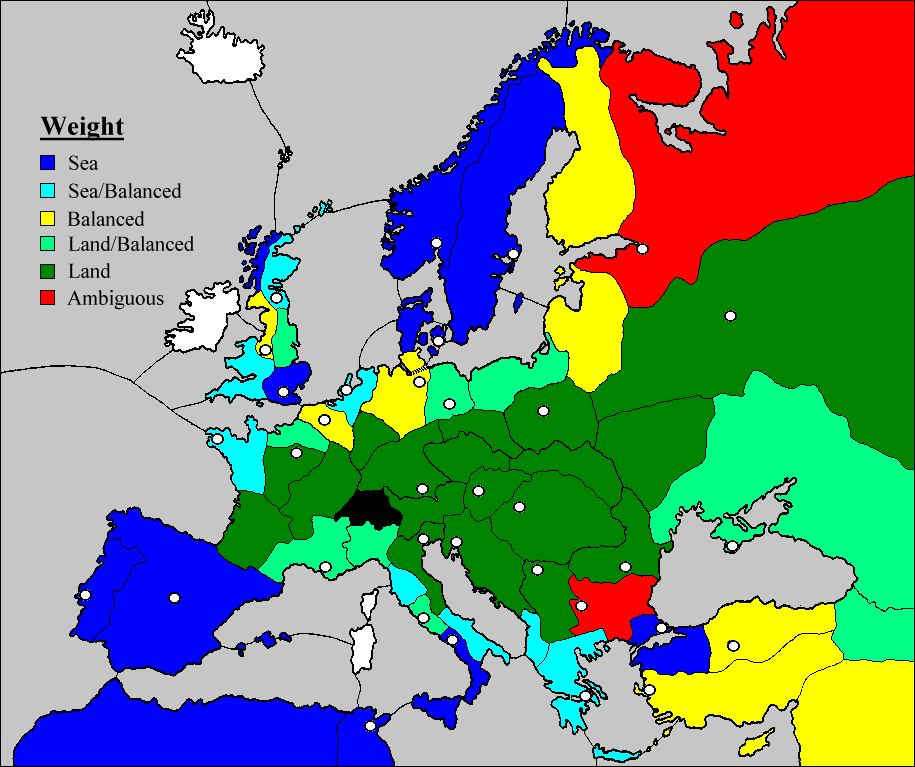I had a peculiar passion for the navy. It sprang to no small extent from my English blood. When I was a little boy… I admired the proud British ships. There awoke in me the will to build ships of my own like these some day, and when I was grown up to possess a fine navy as the English.—Kaiser Wilhelm II, My Early Life
Shortly after he became ruler of the German Empire in 1888, Kaiser Wilhelm began to set plans in motion to achieve his childhood dream. He faced something of a battle within his own government — the German army was well established, and its entrenched interests were loathe to let resources be diverted from the land forces to build up a significant fleet. However (for perhaps the only time in his reign) the Kaiser acted temperately and with subtlety, putting his program into place slowly, with small but significant steps.
One month after acceding to the throne, he appointed a new head of the German Admiralty. In 1889, he reorganized the leadership of the German navy by splitting off naval functions from the German Imperial Military Cabinet into a new Ministry dedicated solely to naval affairs, and filled this new Marine-Kabinett with more of his own appointees. In 1897, Admiral Alfred von Tirpitz was appointed State Secretary of the Imperial Navy Office. Admiral von Tirpitz introduced the first of Germany's five Naval Laws the very next year. Each of these Naval Laws mandated the development of an increasingly larger German Navy, with the express purpose of opposing the United Kingdom — a nation which German policy had until then viewed as friendly — and intimidating the UK into making economic and colonial concessions to the German Empire.
So how did all this turn out?
To make a long story short: it was a disaster. The new aggressive German naval policy completely alienated Britain and siphoned resources away from the German Army, and didn't pay off in terms of military strength. When World War One broke out, the German High Seas Fleet saw little action. It proved unable to break the economy-destroying blockade that the Royal Navy imposed, and Germany went down in a crushing defeat. In fact, it was only earlier this month that Germany finally paid off the last of its reparations owing from the conflict.
Obviously a massive German naval build up didn't work out so well for Imperial Germany in real-world history. But what about in Diplomacy? Can that be the key to ultimate victory?
Well, as I'm sure we can all agree, if you want to win the game it's generally a good idea to have some naval power at least! The Diplomacy map is set up in such a way that it's difficult, if not outright impossible, to reach eighteen centers without some sort of fleet support. And that's certainly true for Germany, who will almost certainly be looking to count Scandinavia and the English home centers among his final eighteen before all is said and done. In Diplomacy World #109 ("German Naval Power" on page 15 of the PDF here), Joshua Danker-Dake takes the position that naval power is particularly important for Germany.
However, I'm less convinced. In fact, I believe that building up the German Navy too early can be damaging to Germany's long term prospects — it can be a terrible mistake tactically, strategically, and diplomatically. In particular, a two-fleet build in 1901 is almost invariably a colossal blunder.
Tactical Disadvantages of the German Two-Fleet Build
Let's consider the situation after 1901. Assuming that the Kaiser has managed to avoid any significant mis-steps or aggressive attacks from a neighbor — and putting aside the possibility of a Sealion Opening against England for the moment — Germany should manage to take both Holland and Denmark, for a total of two builds. There will therefore be one German unit in Denmark, and one in Holland. Since we're leaving both Kiel and Berlin open for fleet builds, the third unit — an army — most likely ended up in Ruhr after a failed attempt on Belgium, or perhaps moved back to Munich in order to cover the center.
For example, let's say that everything started peacefully. German diplomacy was successful in convincing various neighbors to accept BUR, TYR, BOH, SIL, and PRU as demilitarized zones, and there was no clash over Belgium or Sweden. With no open enemy and all landward approaches to Munich at least temporarily secured, Germany builds two fleets:
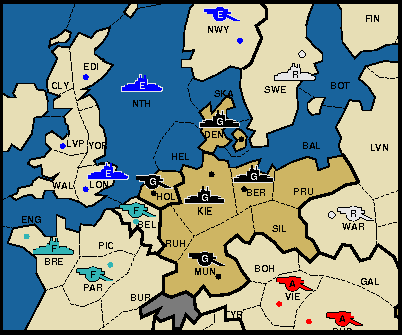
The situation may be different from what's shown here — perhaps the German army is in Ruhr rather than Munich, or England took Norway with a fleet rather than convoying the army, or there was a bounce in Belgium so France's army remained in Picardy instead. Whatever the precise outcome, let's assume that Germany took his expected builds, and at this point has no overt enemies.
So. Now what?
It Hampers Expansion
Even assuming that the choice of first enemy/victim is up to the Kaiser — which is questionable, given that the two-fleet build is likely to have diplomatic repercussions that may not favor Germany — how does building a third fleet help set up any German attack in 1902 that couldn't be carried out better with a third army instead?
Consider Germany's possible targets, and how Germany's build affects them from this position:
- Austria: An early German attack on Austria is unlikely in any case. If Germany begins 1902 with only two armies, such an attack is rendered almost impossible.
- England: You might expect England to be a prime target for German naval power. However, the fact is that any fleet in Berlin takes a full year just to reach a position where it could even attack England. The fastest path west goes to Kiel in the Spring 1902, and then to HOL, HEL, or DEN in the Fall. By 1903, Germany could conceivably have all three fleets in position to threaten the North Sea — yet still not be able to dislodge the English fleet there, unless Germany has active help from France and/or Russia.
- France: The fleet in Berlin will take even longer to reach the French front than it would the English. And while Germany can still set up a Fall attack on Belgium by moving A HOL-RUH and F KIE-HOL in the Spring, that leaves the Kaiser with a dilemma. Even assuming his attack is successful, does he occupy Belgium by ordering A RUH-BEL, F HOL S A RUH-BEL, A MUN-BUR — thus leaving an opening in RUH that will take another season to fill before the line is once again solid — or does he order F HOL-BEL with support from RUH instead, thus occupying Belgium with a fleet that will not be able to support army action into BUR?
- Russia: This is the case where a two-fleet build does the least damage to Germany's prospects. All three fleets can be moved into position to strike at Sweden (F DEN-SKA, F KIE-DEN, F BER-BAL), or Fleet Berlin can cover Prussia. However, this comes at the cost of the land front. It would be different if it were possible to start the year with both armies ready to strike eastward: but since Germany obtained two builds in 1901, at least one German army must have ended 1901 in Denmark or Holland. It will take the Kaiser considerable time to redeploy that army to the east (or to seize Sweden and build), meaning that the Russian home centers of Warsaw and Moscow are in no immediate danger from Germany alone.
These objections are just as true, or even magnified, if the positions of the German fleet in Denmark and army in Holland are reversed.
Of course, a solid alliance can make up for the problems mentioned here. However, as far as I can tell, an alliance against any of Germany's neigbors would function just as well with only one German fleet build at most. I don't see how building a second new fleet actually helps in any of these cases. It merely reduces Germany's options, and gets in the way.
If the Kaiser has a victim in mind in 1901, he could also make a more aggressive move in Fall 1901 — for example, bouncing Russia in Sweden and moving A MUN-SIL to put the Tsar on the defensive. However, that commits him all the earlier to a course of action that may be ill-advised. And again, I don't think that a third fleet makes up in offensive capability for what it sacrifices in terms of tactical flexibility.
If Germany manages to get three builds in 1901, the situation may be somewhat better. For example:
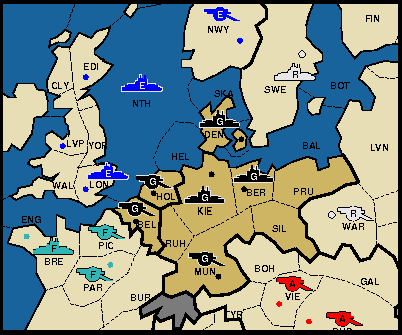
Here, Germany could mobilize against France more easily, supporting A HOL to RUH while covering the Holland space with F KIE-HOL. However, the third German fleet still cannot deploy against France or England in less than a full year, and German armies will still take time to reach the East if the Kaiser decides that Russia is the target instead.
Note also that if Germany gets three builds in 1901, the fleet may well be in Holland or Belgium rather than Denmark, because the Kaiser tried the Blitzkrieg Opening (F KIE-HOL, A MUN-RUH, A BER-KIE).
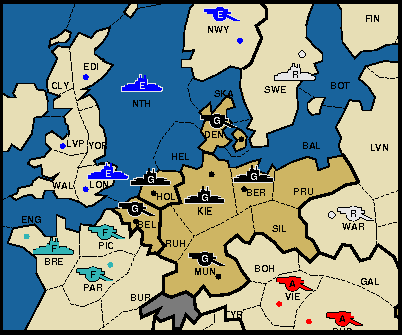
Again, I don't see how this helps in any way. A fleet in Holland or Belgium cannot affect action inland, and an army in Denmark cannot affect action in any of the surrounding sea areas.
Even once Germany has begun to grow and prosper, it may still not be the best idea. For Germany, fleets just take a long time to deploy. It may be a good option later in the game if the Kaiser has a chance to stab quickly into a demilitarized north before his erstwhile ally can respond. However, on balance I think the tactics favor an expansion of the High Seas Fleet that is both gradual and limited.
It Is Defensively Weak
So much for offense. However, that assumes that everything is going Germany's way diplomatically: and that isn't always the case. What about defense?
It should be obvious from looking at any of the maps above that if Germany's landward neighbors get together to make a concerted attack, Munich is in serious danger. Austria (or even Italy), France, and Russia can easily get two or three armies in position to attack the center in 1902. The fact that it's unsupported only makes it a more tempting target.
The only obvious way to defend against such an attack is to move the second army down from Holland or Denmark to Kiel or Ruhr right away, effectively beginning your Spring 1902 campaign season with a retreat.
This process of rearranging forces itself makes Germany vulnerable. Moving the army down from Holland means that the unit in Holland can't be supported in place if France and England decide to make a joint attack on it. Similarly, any move down from Denmark to Kiel prevents a defensive support there — and because units cannot directly exchange places, it leaves Denmark open for a full turn.
Of course, the delay incurred by all this shuffling of units slows down German expansion further.
If the Kaiser is brave, he may well decide to ignore the possible danger, instead trusting in his diplomatic prowess (and/or his neighbors' lack of same) to ensure that he's safe until he's able to build more armies. However, that's a serious gamble. The very fact that Munich is vulnerable will encourage attacks on it.
Where Do Germany's Eighteen Come From?
Okay. So tactically, it probably isn't that smart for Germany to put too much focus on naval power too early in the game. Still, what about the longer term? What about the grand strategic picture?
In looking at the strategic aspects of German naval power, I'm going to cite two articles that have appeared in previous issues of the Pouch:
- The Statistician: Solo Victories by Josh Burton — A fascinating look at where each of the victorious Great Powers gets its eighteen centers.
- Divisions and Dreadnoughts: — My own look at how the topography of the board informs the effectiveness of sea vs. land forces for each Great Power.
I think that both of them show that Germany should generally adopt a strategy that favors the buildup of land forces over naval forces.
One of the things that I most admire about Josh's article is the way that it illustrates the breakdown of centers for each of the Great Powers. He presents a map for each Great Power, shading each supply center in the color of that Great Power according to how often it's included as one of that country's final eighteen. It's a very striking visual representation of each country's natural paths of expansion.
For Germany, the map ends up looking like this:
If you look at this map closely, you'll notice a few interesting points worth considering:
- A victorious Germany is more likely to occupy Warsaw (87.2%) than Paris (85.71%), London (85.71%), Liverpool (82.75%), or Brest (82.48%).
- A victorious Germany is more likely to occupy Moscow (75.47%) than Marseilles (67.12%), Portugal (55.66%), or Spain (53.64%).
- Overall, the greatest likelihood is that a victorious Germany will occupy all of its side of the Main Stalemate Line except Spain, plus Warsaw and Moscow.
- Of the other supply centers on the far side of the Main Stalemate Line, a victorious Germany is less likely to occupy Tunis (13.07%) than Vienna (45.01%), Budapest (29.78%), Sevastopol (29.11%), Rumania (22.1%), Trieste (18.46%), Venice (16.04%), or even Serbia (13.34%). While these centers are not likely choices individually, it seems to me that the chance that Germany will take at least one of them in place of a western center isn't too bad.
- The chance that a victorious Germany will occupy any of the remaining supply centers is under 6% for each center.
Warsaw, Moscow, and Vienna are of course completely landlocked centers, so it should be obvious right off that any Kaiser who wants to cross the Main Stalemate Line quickly is going to have to rely on armies to do it. However, the strategic importance that armies have for Germany also depend on the board's topography:
This map comes from my article on sea power. In it, I analyzed each space on the board according to whether it was more vulnerable to attacks from fleets, or from armies. Any completely inland border counted as one point for land; a border with a sea area counted as one for sea; and a border along a coast counted for each (since either an army or a fleet can move along the coast).
When compared to the list of top German centers, the split does seem to favor Germany putting more effort into sea power than land power. Counting StPetersburg as Sea/Balanced (since Germany can attack it with up to five fleets, but no more than four armies), that leaves nine centers as Sea or Sea/Balanced (POR, LON, EDI, DEN, HOL, NWY, SWE, STP) and three as Balanced (KIE, LPL, BEL) to only six that are definitely Land/Balanced (MAR, BER) or decisively landlocked (PAR, MUN, WAR, MOS). A victorious Germany doesn't have to match that particular configuration, of course, but from Josh's statistics, those are the favored centers. Even if you trade Portugal (say) for the somewhat less likely Vienna, sea power comes out ahead.
However, that ignores a crucial aspect of the board: the Swiftest Route to Victory.
If you haven't read about it before, the concept of the Swiftest Route to Victorywas first introduced by Paul Windsor in his seminal article Geography is Destiny. Basically, Paul proposed that a significant component of a Great Power's success depends on how quickly it can get to eighteen centers. A Great Power like Austria or Germany, which has eighteen supply centers within three moves of its home supply centers, is more likely to grab and hold those centers than a Great Power like England or Turkey that must go further afield from its home centers to win.
Normally, the Swiftest Route to Victory doesn't differentiate between routes that use armies and routes that use fleets. However, when you do make that distinction, the effect on Germany is striking:
| Power | Start (0 Moves) |
Centers Reachable In... | Total Moves |
||||||
|---|---|---|---|---|---|---|---|---|---|
| 1 Move | 2 Moves | 3 Moves | 4 Moves | 5 Moves | 6 Moves | 7 Moves | |||
| Both | Kie, Ber, Mun | Hol, Den | Mar, Par, Bel, Swe, War, Vie, Tri, Ven | (5 of 11) Spa, Bre, Lon, Edi, Nwy, StP, Mos, Rum, Ser, Rom, Bud | 33 | ||||
| Armies only | Kie, Ber, Mun | Hol, Den | Mar, Par, Bel, Swe, War, Vie, Tri, Ven | (5 of 9) Spa, Bre, Nwy, StP, Mos, Rum, Ser, Rom, Bud | 33 | ||||
| Fleets only | Kie, Ber, Mun | Hol, Den | Bel, Swe | Nwy, StP, Edi, Lon | Bre | Lvp, Por, Spa | Tun, Mar | (1 of 2) Rom, Nap | 57 |
From this analysis, the number of moves that it would take Germany to reach eighteen centers using only fleets is close to double the moves it would take to do the same with only armies. Many of the centers closest to Germany's home centers are completely landlocked. Even those that are more vulnerable to fleets than armies can often be reached just as quickly, or faster, overland as compared to by sea.
Of course, all this analysis is only looking at the issue from the point of view of a victorious Germany looking to expand. Of course, France and England overwhelmingly include the German home centers in their victory counts: but what about a victorious Austria, or Italy, or Russia, or Turkey? Any of those countries has to cross the Main Stalemate Line to win. Where will they go to do it?
Have a look at the other maps in Josh's article. According to his analysis:
- Austria is more likely to take both Munich (77.46%) and Berlin (55.11%) than Tunis (54.36%).
- Italy is more likely to take Munich (46.72%) than either Warsaw (39.75%) or Moscow (34.88%), or Paris (29.39%) or Brest (31.71%).
- Russia is more likely to take Berlin (86.79%) than any Balkan centers except Vienna (87.52%), Budapest (88.39%), and Rumania (92.02%). Russia is also more likely to take Munich (71.55%) than any remaining Balkan centers but Serbia (74.02%) and Ankara (72.71%)
- Turkey is only slightly more likely to get his final supply center from Marseilles (47.67%) than Munich (43.93%).
For Russia, which starts off with home centers on both sides of the line, this isn't as much of an issue. And Turkey, which can't reach Germany easily, cannot easily take advantage of any German weakness on land. However, in the midgame a successful Italy or Austria will have powerful incentive to strike across the Alps as soon as they can if they mean to win. And German fleets cannot stop them.
Overall, there's definitely a place for naval power in the Kaiser's long-term plans. However, the Germany has to make it into the long-term in the first place. Which leads to my last point...
Don't Forget, The Game Is Called DIPLOMACY
I mentioned earlier that building up a navy too quickly can have a detrimental effect on German diplomacy. In 1901 a two-fleet build limits offensive opportunities and leaves Germany weak, which in itself is enough to encourage an attack from neighbors.
However, I think that ultimately, the strongest reason to avoid a premature buildup of German naval power is purely diplomatic: it is almost certain to make enemies of England and Russia, with all the diplomatic and military complications that entails.
Realistically, a large High Seas Fleet can only be used in two areas of the board: Scandinavia, and the British Isles. Both of these areas are of direct interest to England. Any Prime Minister worth his salt who sees a large German fleet — whether at the beginning of 1902, or later — cannot afford to ignore that threat. He or she will make a deal with the Tsar, and/or President. He will encourage the Austrian to move on Munich.
What choice does he have? His country is an island!!!
As for Russia, you can be sure that a competent Tsar(itsa) is well aware of the threat that fleets pose to the Russian position in Sweden... and Norway... and, ultimately, to StPetersburg. While the Russian player may be glad for the opportunity to grab Norway from an England who is too concerned about home centers to bother defending it, the gratitude of princes is grudging, and does not last. You can be sure that even while the Cossacks are marching into Oslo, telegraphs are zipping between the Winter Palace and the Champs Elysées, encouraging France to join in containing the German threat before it's too late. After all, those German fleets face a dead end in StPetersburg, so where will they go after that, if not to the Channel and Mid-Atlantic?
As for the French... well, a large German navy does not pose an immediate threat. The President may be quite happy to let England and Russia handle Germany at first. After all, it's really their problem anyway. Besides, France may well see England as the greater threat — in which case the President is more likely to invade England than charge to the country's rescue.
However... that won't necessarily be the case. You can be sure that England will be trying very hard to persuade France to ally. Russia may be doing the same, with the added promise of facing down England once Germany is gone.
Even if France remains loyal, the Tsar can try to entice Austria to help out by offering an alliance to crush Turkey in the south in exchange for a little help in the North. And as we've seen earlier, Munich is Austria's most likely center on the far side of the stalemate line. And if Austria won't bite, perhaps Italy will...
Conclusion
Now, a two-fleet German build in 1901 is admittedly rare. However, it should be! Building two fleets so early on is a poor investment for the Kaiser to make in those crucial first few years.
Even once Germany has begun to grow and prosper, a large fleet is generally not the best idea until late in the game. For Germany, fleets just take a long time to deploy. That gives any target ample time to prepare, both militarily and diplomatically. Disproportionate fleet construction just tips the German player's hand, and sacrifices flexibility without gaining significant advantages in return.
If the Kaiser has a chance to stab quickly into a demilitarized north before his erstwhile English or French ally can respond, a sudden surprize navy may be the action that wins the game. However, on balance I think the tactics favor an expansion of the High Seas Fleet that is both gradual and limited.
So the next time you're Germany, consider your fleet builds carefully. Don't repeat the Kaiser's mistake.
 |
Charles Roburn ([email protected]) |
If you wish to e-mail feedback on this article to the author, and clicking on the envelope above does not work for you, feel free to use the "Dear DP..." mail interface.


